Last week LEGO announced an interesting new robotics system called LEGO BOOST. It is aimed at kids as young as 7 years old, who are not quite yet ready for LEGO MINDSTORMS, but would like to get into programming. LEGO BOOST is also cooler looking than LEGO WeDo, the curriculum-based classroom product available to schools. Below is the press-release with detailed information, as well as a video-introductions. 🙂
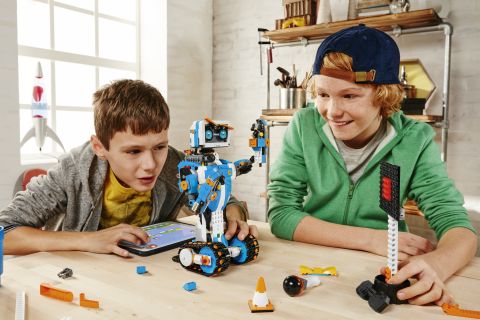
#17101 LEGO BOOST Creative Toolbox, available August 2017
Combine the versatile LEGO building system with advanced technology to boost your creativity with the awesome LEGO BOOST Creative Toolbox.
Download the free tablet app to your device and follow the step-by-step instructions to build and code any of the 5 multifunctional models. Experience Vernie the Robot—a moving and talking robot; the M.T.R.4 (Multi-Tooled Rover 4)—a robust, versatile rover with 4 different tool attachments including a spring-loaded shooter; the Guitar4000—a musical instrument with pitch bend and sound effects; Frankie the Cat—an interactive pet that plays, purrs and expresses its mood; or the AutoBuilder—an automated production line that really builds miniature LEGO models!
Bring your creations to life with the app’s intuitive, icon-based coding interface and complete an array of exciting activities designed for each model. This set also includes a playmat for use with specific activities, and a LEGO BOOST wall poster!
Take your LEGO play to the next level with the amazing LEGO BOOST Creative Toolbox. Build and code interactive, motorized robots, models and creations with distance, color and tilt sensor technologies.
- Includes 843 LEGO pieces, plus a LEGO Move Hub, Interactive Motor and a Color & Distance Sensor.
- Move Hub features Bluetooth Low Energy (BLE) connectivity, two encoded motors, activation button, internal tilt sensor and a light.
- Interactive Motor is an encoded motor.
- Color & Distance Sensor detects distance, motion and color, and can also function as a light.
- Check out the cool white, orange and blue color-scheme.
- Rotate Vernie’s head to activate its shoulder-mounted spring-loaded shooter.
- Build the M.T.R.4 (Multi-Tooled Rover 4) and try out the different tool and customization attachments to prepare the vehicle for an array of exciting activities.
- Learn how to play a song and rock out with the Guitar4000.
- Look after your own pet with Frankie the Cat. Be sure to feed it the right food—or it might get upset!
- Construct, code and operate the AutoBuilder to produce real miniature LEGO models.
- Build and code robots and models, and complete exciting activities with the playmat and intuitive LEGO BOOST app, available for iOS and Android tablet devices.
- Easy-to-use intuitive software with icon-based drag-and-drop coding interface.
- Building instructions for all 5 models are included with the free LEGO BOOST app.
- This product requires 6 AAA batteries (not included). Alkaline batteries are recommended, but rechargeable batteries can be used, though may result in weaker power output.
- Vernie the robot stands over 10” (27cm) tall.
- M.T.R.4 (Multi-Tooled Rover 4) measures over 4” (12cm) high, 9” (23cm) long and 5” (14cm) wide.
- Guitar4000 measures over 1” (5cm) high, 16” (42cm) long and 5” (15cm) wide.
- Frankie the Cat stands over 6” (17cm) tall.
- The AutoBuilder measures over 10” (27cm) high, 7” (19cm) long and 6” (16cm) wide.
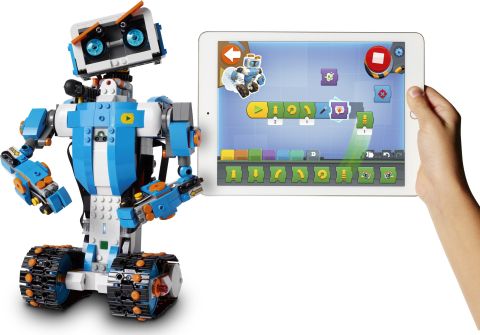
➡ Build the creation you want – LEGO BOOST combines the endless play opportunities of a traditional LEGO set with an endless variety of movement and sound capabilities made possible through an easy-to-use, app-based coding environment. LEGO BOOST has been developed for children ages 7 and older by an international team of LEGO designers. Using familiar LEGO elements and simple coding language, LEGO BOOST delivers an intuitive approach and opportunities for quick success.
Powered by a Move Hub, a LEGO stud-covered brick with built-in tilt sensor upon which children can add LEGO elements, motors and a sensor that combines color and distance detection, LEGO BOOST brings movement to any LEGO creation. The set includes building instructions for five diverse models; Vernie the Robot, Frankie the Cat, the Guitar 4000, the Multi-Tool Rover 4 (M.T.R.4), and the Autobuilder, each designed to give children the basic building and coding skills needed to express their creativity by personalizing whatever they build.
“We know that children dream of bringing their LEGO creations to life, and our chief ambition for LEGO BOOST is to fulfill that wish. Once children build a LEGO creation, we give them simple coding tools to ‘BOOST’ their models by adding personality,” said Simon Kent, design lead for the LEGO Group. “We want children to first and foremost have a fun and limitless play experience, adding the coding opportunity is the means to get there.”
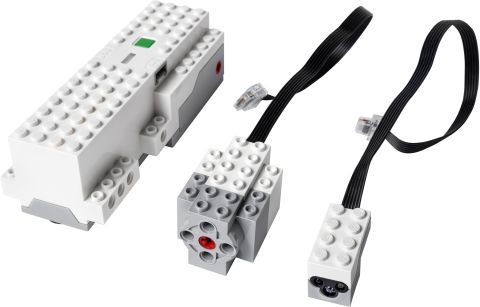
➡ Coding brings your creation to life – LEGO BOOST introduces children to coding through a free downloadable app that contains the guidance, building instructions and simple coding commands to bring to life five LEGO creations, one at a time. Much like building with LEGO bricks, children build behaviors and actions by linking digital coding blocks in an easy-to-understand horizontal layout. To further personify the experience, LEGO BOOST lets children add voice recordings to their creations, adding personality without requiring spelling and typing. The app also includes more than 60 activities designed to inspire additional building, coding and play.
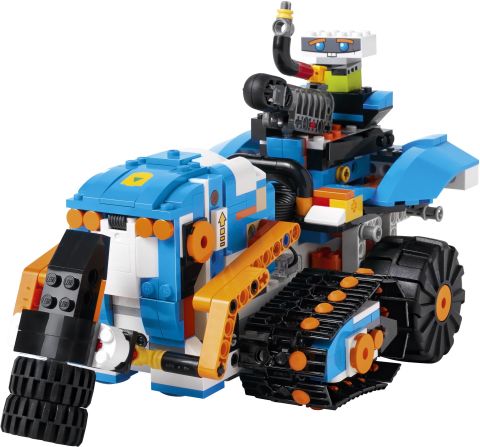
➡ Creative canvas lets you boost any LEGO creation – To further inspire creative building and coding, the LEGO BOOST app includes a “creative canvas” that includes basic building instructions for three simple base models that children can use to customize their own LEGO creations. The three bases available at launch include: a walking base for making animals like a dragon or a pony, a driving base for building vehicles like a dune buggy or rover, and an entrance base so that children can make their own castle, fort, or even a futuristic space station. Once children are comfortable with building and coding the various LEGO BOOST models, they can use the kit to “boost” any LEGO creation – from LEGO City and LEGO Friends to LEGO Ninjago and The LEGO Batman Movie.

LEGO BOOST will be available at most stores and online shopping sites where toys are sold, through select consumer electronics retailers, and at LEGO Stores and shop.LEGO.com in the second half of 2017 and will have a suggested retail price of $159.99 USD $159.99 (EUR) and $199.99 (CAD). For more information, visit LEGO.com/BOOST.
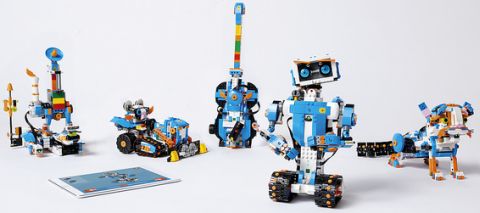
I find this to be a very interesting development. While LEGO MINDSTORMS is definitely popular and extensively used in school programs and after school activities, the $350 price-tag, the 10+ age-range, and LEGO Technic-based building system didn’t make it accessible to everyone. The LEGO BOOST hardware seems to be more similar to the LEGO WeDo educational kit, and they also both use mostly regular LEGO system bricks instead of just LEGO Technic. So it seems like LEGO BOOST is a simpler, friendlier and cheaper version of LEGO MINDSTORMS, but cooler, fresher and more accessible than LEGO WeDo, which is geared towards schools. I just hope it won’t end up lie LEGO FUSION, which also sounded excellent and had great potential, but ended up being full of problems.

What do you think? How do you like the LEGO BOOST Creative Toolbox so far? Is this something you are interested in? How do you think it compares to other LEGO robotics kits? Feel free to share your thoughts and discuss in the comment section below! 😉
And you might also like to check out the following related posts:
- Build LEGO Robots with Yantra Robotics
- Starting Out with LEGO Robotics
- Making of a LEGO Paper Plane Machine
- LEGO Mindstorms Easter Egg Decorator Robot
- LEGO Mindstorms Robot – LEGONADRO the Artist
- Walking LEGO Animals – So Much Fun!
- LEGO Pop-Ups & More Magical Creations
- LEGO Mindstorms the Ultimate Useless Machine
- The Great LEGO Ball Contraption…
- LEGO Education Panama Canal












As a parent to a 5th grader I am interested in this. I can’t see spending $350 on Mindstorms but I’ll lay out $160 for Boost this summer or fall I think if my daughter is interested in it.
Yes, I have heard a number of people mentioning similar things. $350 is steep, but $160 is reasonable. I think set is going to be very popular.
I wonder how this compares to Little Bits?
http://littlebits.cc/tips-tricks/tips-tricks-littlebits-lego
Is Little Bits an app-based programming platform? I’m not that familiar with it.
I think this is a very cool idea from LEGO. The programming options and innumerable building possibilities should appeal to kids a lot. All the models look pretty interesting, but my favorite is the MTR4 – I like tracked vehicles. 🙂 The AutoBuilder is intriguing; I doubt it “really builds miniature LEGO models,” unless it just puts bricks randomly onto a plate. Actually building models seems too complex for kids or the program. 😕
Additionally, there are plenty of notable parts in the set, particularly the rubber track nubs in orange, orange donut-plates, and several new-for-2016 pieces. And what shade of blue does it use? I can’t tell if it’s normal blue, or Dark Azur.
I agree in that BOOST is basically a simplified and System-based version of Mindstorms. The mechanics are the same: a main hub (in Mindstorms the NXT), a motor (in Mindstorms called a servo), and some sensors. Then the programming is also similar, as it’s just placing pre-programmed code blocks in a row, although it looks like Mindstorms offers more complex possibilities than BOOST will. However, EV3 has more sensors than the three in this BOOST set, although perhaps there will be additional BOOST sets with more sensors or motors. Truly, the biggest differences are the colors and the price: BOOST is less than half the price of Mindstorms, and has a way more friendly look to it. You can argue the difference between Technic and System building, but recently System has become just as complex as Technic, with that huge variety of tiny, fiddly parts.
I never heard what became of FUSION, as I couldn’t get the app and so forgot about it. But I think BOOST hopefully shouldn’t have many (or any) problems, since its program is so similar to Mindstorms, which works well.
One interesting thing to add, is that as far as I know MINDSTORMS and BOOST won’t be compatible. They use different connectors. Hopefully at some point LEGO will be able to standardize their robotics/electronics system because right now we have Power Functions, MINDSTORMS, the LEGO Education kits, and now BOOST, and they all use different systems (as far as I know).
I don’t think FUSION will ever be compatible with anything, but then I never fully understood how it worked. Didn’t it scan the base and somehow see what was built on top via a picture?
Powers Functions are already semi-compatible with Mindstorms, since you can use an NXT and servo to control a normal IR Remote, if that counts. The older Mindstorms (from 1999) could be compatible as well, since they have the 2X2 tabs like normal PFs. But yes, most of the Education sets like WeDo 2.0 don’t have connectors compatible with others, and BOOST’s connectors look different as well. Standardizing all the systems would be interesting, although maybe the different systems (NXT, EV3, etc.) can’t work together, which is why LEGO chose not to sync them. 😕
Sorry, I meant to say MINDSTORMS. Not FUSION. FUSION is gone for good. I was reading somewhere that BOOST should be compatible with the WeDo kits as they appear to have the same connectors.
WeDo was USB compatible, apparently, so it should be more compatible than more insular systems, I think…
Oh, interesting. Yes, that makes sense.
And Boost had wireless Bluetooth…
Yes! I’m actually really looking forward to try this out as I just got a new tablet for Christmas with Bluetooth. 😀
Oh yeah, that Fusion thing was never available outside of USA…
It’s Dark Azur according to Brothers Brick …
http://www.brothers-brick.com/2017/01/06/exclusive-hands-lego-boost-robotics-prototype-ces-las-vegas-news-video/
31062 Robo Explorer seems to be in Medium Azur, so it’s a slightly different nuance.
How sensitive are the color detecting sensors? Can they tell the difference between old light gray and new light gray? The BOOST might be able to become an automated brick sorter that sorts by color .
Interesting question. I guess we will have to wait and see how sensitive are the sensors. Telling the difference between old and new light-gray is a very difficult task, especially since the newer color has lots of variations. A slightly yellowed new light-gray would look pretty much identical to an old light-gray piece.
Yeah, my Old Light Gray parts could vary wildly in hue, depending on yellowing…
And some of my White parts have yellowed to a near Tan color…
I also have some whites that are completely tan. It really is a strange thing that they chance color so much.